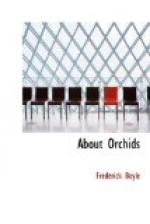From the Ruby Mines also comes a Dendrobium so excessively rare that I name it only to call the attention of employes in the new company. This is D. rhodopterygium. Sir Trevor Lawrence has or had a plant, I believe; there are two or three at St. Albans; but the lists of other dealers will be searched in vain. Sir Trevor Lawrence had also a scarlet species from Burmah; but it died even before the christening, and no second has yet been found. Sumatra furnishes a scarlet Dendrobe, D. Forstermanni, but it again is of the utmost rarity. Baron Schroeder boasts three specimens—which have not yet flowered, however. From Burmah comes D. Brymerianum, of which the story is brief, but very thrilling if we ponder it a moment. For the missionaries sent this plant to Europe without a description—they had not seen the bloom, doubtless—and it sold cheap enough. We may fancy Mr. Brymer’s emotion, therefore, when the striking flower opened. Its form is unique, though some other varieties display a long fringe—as that extraordinary object, Nanodes Medusae, and also Brassavola Digbyana, which is exquisitely lovely sometimes. In the case of D. Brymerianum the bright yellow lip is split all round, for two-thirds of its expanse, into twisted filaments. We may well ask what on earth is Nature’s purpose in this eccentricity; but it is a question that arises every hour to the most thoughtless being who grows orchids.
[Illustration: DENDROBIUM BRYMERIANUM. Reduced To One Fourth.]
Everybody knows Dendrobium nobile so well that it is not to be discussed in prose; something might be done in poetry, perhaps, by young gentlemen who sing of buttercups and daisies, but the rhyme would be difficult. D. nobile nobilius, however, is by no means so common—would it were! This glorified form turned up among an importation made by Messrs. Rollisson. They propagated it, and sold four small pieces, which are still in cultivation. But the troubles of that renowned firm, to which we owe so great a debt, had already begun. The mother-plant was neglected. It had fallen into such a desperate condition when Messrs. Rollisson’s plants were sold, under a decree in bankruptcy, that the great dealers refused to bid for what should have been a little gold-mine. A casual market-gardener hazarded thirty shillings, brought it round so far that he could establish a number of young plants, and sold the parent for forty pounds at last. There are, however, several fine varieties of D. nobile more valuable than nobilius. D. n. Sanderianum resembles that form, but it is smaller and darker. Albinos have been found; Baron Schroeder has a beautiful example. One appeared at Stevens’ Rooms, announced as the single instance in cultivation—which is not quite the fact, but near enough for the auction-room, perhaps. It also was imported originally by Mr. Sander, with D. n. Sanderianum. Biddings reached forty-three pounds, but the owner would not deal at the price. Albinos are rare among the Dendrobes.




